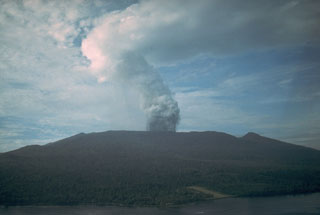Report on Karkar (Papua New Guinea) — September 1990
Bulletin of the Global Volcanism Network, vol. 15, no. 9 (September 1990)
Managing Editor: Lindsay McClelland.
Karkar (Papua New Guinea) No vapor emission; vegetation re-established
Please cite this report as:
Global Volcanism Program, 1990. Report on Karkar (Papua New Guinea) (McClelland, L., ed.). Bulletin of the Global Volcanism Network, 15:9. Smithsonian Institution. https://doi.org/10.5479/si.GVP.BGVN199009-251030
Karkar
Papua New Guinea
4.647°S, 145.976°E; summit elev. 1839 m
All times are local (unless otherwise noted)
"Karkar was inspected from the air on 3 September. There was no sign of vapour emission from Bagiai cone (the focus of the 1974 and 1975 eruptions), or from the 1979 crater. Vegetation now covers a large proportion of the floor of Karkar's inner caldera (almost completely denuded in the 1979 eruption), and also extends into the 1979 crater."
Geological Summary. Karkar is a 19 x 25 km forest-covered island that is truncated by two nested summit calderas. The 5.5 km outer caldera was formed during one or more eruptions, the last of which occurred 9,000 years ago. The steep-walled 300-m-deep, 3.2 km diameter, inner caldera was formed sometime between 1,500 and 800 years ago. Cones are present on the N and S flanks of this basaltic-to-andesitic volcano; a linear array of small cones extends from the northern rim of the outer caldera nearly to the coast. Recorded eruptions date back to 1643 from Bagiai, a pyroclastic cone constructed within the inner caldera, the floor of which is covered by young, mostly unvegetated andesitic lava flows.
Information Contacts: C. McKee, RVO.

